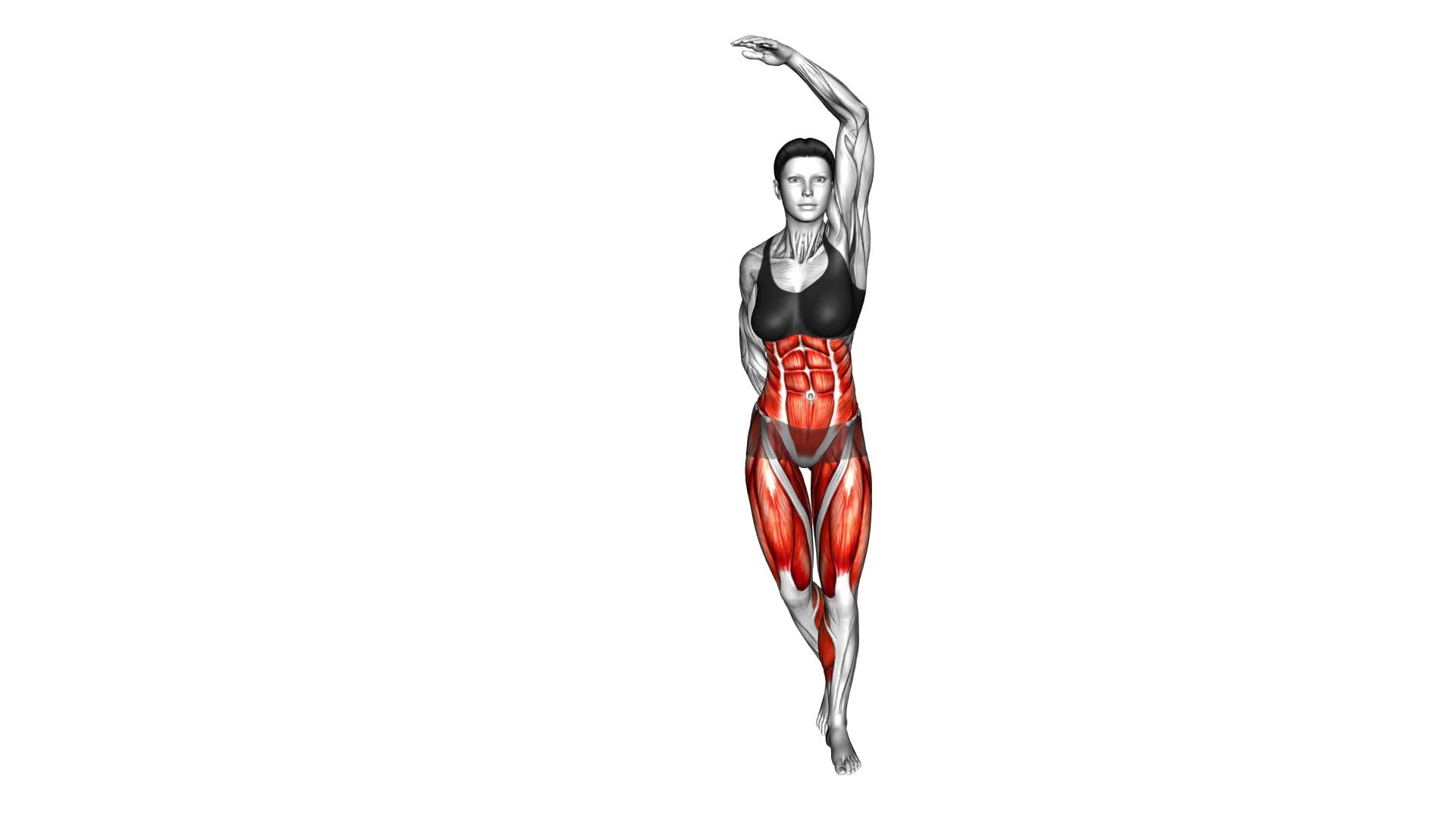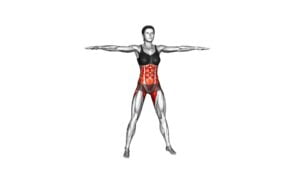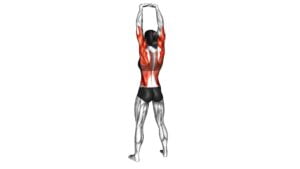Stepback Side Bend (female) – Video Exercise Guide & Tips

Get ready to tone your core and improve your flexibility with the Stepback Side Bend. This exercise targets your obliques and helps you achieve a stronger, leaner physique.
Watch This Exercise Video
In this video exercise guide, you'll learn the proper form and technique, along with helpful tips to maximize your results. Whether you're a beginner or a fitness enthusiast, this exercise is perfect for adding variety to your routine.
So grab a mat and let's get started!
Key Takeaways
- The Stepback Side Bend targets obliques, transverse abdominis, and rectus abdominis.
- It helps develop a stronger and more stable core.
- Proper form and technique are important, including engaging the core and maintaining a straight back.
- Modifications and progressions can be made to increase the challenge and effectiveness of the exercise.
Benefits of the Stepback Side Bend
To maximize the effectiveness of your workout, it's important to understand the benefits that can be gained from incorporating the Stepback Side Bend into your routine.
This exercise primarily focuses on core strengthening and improved flexibility.
The Stepback Side Bend targets the muscles in your core, including the obliques, transverse abdominis, and rectus abdominis. By engaging these muscles, you can develop a stronger and more stable core, which is essential for maintaining proper posture and preventing lower back pain. Additionally, a strong core is crucial for performing everyday activities and other exercises with ease.
Incorporating the Stepback Side Bend into your routine also promotes improved flexibility. This exercise involves a lateral bending motion that stretches the side of your body, particularly the muscles in your waist and hips. Regularly performing this movement can help increase your range of motion and alleviate tightness in these areas.
Proper Form and Technique
Mastering proper form and technique is crucial when performing the Stepback Side Bend exercise. To ensure you get the most out of this exercise, it's important to understand some common misconceptions and focus on muscle activation.
One common misconception is that the Stepback Side Bend is primarily a lower body exercise. While it does engage the lower body, particularly the glutes and quads, it also targets the core and oblique muscles. To maximize muscle activation, start by standing with your feet shoulder-width apart and take a large step back with your right foot. Keep your core engaged and your back straight as you bend sideways towards the left, reaching your left hand down towards your left ankle. Focus on feeling the stretch and contraction in your oblique muscles on the right side. Return to the starting position and repeat on the other side.
Another misconception is that you need to bend as far as possible to get results. However, it's important to prioritize proper form over depth of the side bend. Maintain control throughout the movement and avoid relying on momentum.
Modifications and Progressions
To modify and progress the Stepback Side Bend exercise, you can incorporate additional resistance or increase the range of motion. For beginners or those looking for modifications, you can start by using lighter weights or resistance bands to reduce the intensity of the exercise. This will allow you to focus on proper form and build strength gradually. Additionally, you can decrease the range of motion by not going as far down with your side bend, which can help with balance and stability. As you become more comfortable with the exercise, you can gradually increase the weight or resistance, challenging your muscles and promoting further strength and stability gains.
Advanced variations of the Stepback Side Bend can include using heavier weights, performing the exercise on an unstable surface such as a Bosu ball, or incorporating a twisting motion into the side bend. These variations can further engage your core muscles and challenge your balance and coordination. By gradually progressing the exercise, you can continue to challenge your body and avoid plateaus in your fitness routine.
Now, let's move on to the next section and discuss common mistakes to avoid.
Common Mistakes to Avoid
Avoid these common mistakes when performing the Stepback Side Bend exercise to ensure proper form and maximize the effectiveness of the movement.
- Slouching posture: Maintain an upright posture throughout the exercise to engage the correct muscles and prevent strain on your back.
- Lack of core engagement: Remember to engage your core muscles by drawing your navel towards your spine. This will help stabilize your body and enhance the effectiveness of the exercise.
- Overarching the lower back: Avoid excessive arching in your lower back as it can lead to discomfort and potential injury. Focus on maintaining a neutral spine throughout the movement.
- Rushing the exercise: Take your time to perform each repetition with control and precision. Rushing through the exercise can compromise your form and reduce the benefits you can gain from it.
By avoiding these common mistakes and ensuring proper alignment, you can optimize the Stepback Side Bend exercise and achieve better results.
Remember to listen to your body and make adjustments as needed to maintain a safe and effective workout.
Tips for Maximizing Results
To maximize your results with the Stepback Side Bend exercise, focus on proper breathing technique and maintaining a controlled and deliberate tempo throughout each repetition. This will help engage your core muscles effectively and ensure that you're getting the most out of your workout.
In addition to these key points, there are a few other tips that can help you maximize your results.
Firstly, it's important to pay attention to your nutrition and hydration for optimal results. Fueling your body with the right nutrients and staying hydrated will provide the energy needed for your workouts and help with muscle recovery. Make sure to consume a balanced diet that includes a good mix of carbohydrates, protein, and healthy fats. Also, don't forget to drink plenty of water before, during, and after your workout to stay hydrated.
Another tip for maximizing your results is to incorporate resistance training into your routine. Adding resistance, such as dumbbells or resistance bands, can increase the intensity of the exercise and help build strength. This won't only enhance your overall fitness but also help you achieve a more toned and sculpted physique.
Frequently Asked Questions
Are There Any Precautions or Contraindications for Performing the Stepback Side Bend Exercise?
Before performing the stepback side bend exercise, it's important to be aware of any precautions or contraindications. This will ensure a safe and effective workout. Precautions may include avoiding the exercise if you have any existing injuries or medical conditions that could be aggravated. It's always a good idea to consult with a healthcare professional or a qualified fitness instructor to determine if this exercise is suitable for you.
Now let's explore the benefits of the stepback side bend.
How Many Repetitions and Sets Should I Do for the Stepback Side Bend?
To determine the number of repetitions and sets for the stepback side bend exercise, you should consider your fitness level and goals.
It's generally recommended to perform 8-12 repetitions per set, completing 2-3 sets in total. However, it's important to listen to your body and adjust accordingly.
Remember to start with a weight that challenges you but allows for proper form. Gradually increase the intensity as you progress.
Can I Incorporate Weights or Resistance Bands While Performing the Stepback Side Bend?
Yes, you can definitely incorporate weights or resistance bands while performing the stepback side bend. Adding weights or resistance bands can increase the intensity of the exercise and help build strength in your core and oblique muscles.
However, it's important to start with lighter weights or resistance bands and gradually increase the load as you become more comfortable and confident. Always remember to maintain proper form and listen to your body.
Is It Necessary to Warm up Before Doing the Stepback Side Bend Exercise?
It is important to warm up before doing the stepback side bend exercise. Warming up helps increase blood flow, flexibility, and reduces the risk of injury.
To properly warm up, you can engage in light cardio exercises like jogging or jumping jacks.
As for the stepback side bend, make sure to maintain proper form and technique. Keep your core engaged, shoulders relaxed, and avoid any jerky movements.
Remember to listen to your body and start with lighter weights or resistance bands if needed.
Can the Stepback Side Bend Help in Reducing Waist Size or Achieving a Smaller Waistline?
The Stepback Side Bend exercise can be an effective way to reduce waist size and achieve a smaller waistline. By engaging the core muscles and targeting the obliques, this exercise helps to strengthen and tone the waist area.
Incorporating this exercise into your fitness routine, along with a balanced diet and regular cardio, can contribute to a slimmer waistline and improved overall body composition.
Remember to always maintain proper form and consult with a fitness professional if needed.
Conclusion
In conclusion, the stepback side bend is a beneficial exercise for targeting the obliques and improving core strength. By maintaining proper form and technique, you can maximize the effectiveness of this exercise.
Modifications and progressions can be made to suit individual fitness levels. It's important to avoid common mistakes and follow the provided tips to achieve optimal results.
Incorporating the stepback side bend into your workout routine can help you achieve your fitness goals efficiently and effectively.

Author
Years ago, the spark of my life’s passion ignited in my mind the moment I stepped into the local gym for the first time. The inaugural bead of perspiration, the initial endeavor, the very first surge of endorphins, and a sense of pride that washed over me post-workout marked the beginning of my deep-seated interest in strength sports, fitness, and sports nutrition. This very curiosity blossomed rapidly into a profound fascination, propelling me to earn a Master’s degree in Physical Education from the Academy of Physical Education in Krakow, followed by a Sports Manager diploma from the Jagiellonian University. My journey of growth led me to gain more specialized qualifications, such as being a certified personal trainer with a focus on sports dietetics, a lifeguard, and an instructor for wellness and corrective gymnastics. Theoretical knowledge paired seamlessly with practical experience, reinforcing my belief that the transformation of individuals under my guidance was also a reflection of my personal growth. This belief holds true even today. Each day, I strive to push the boundaries and explore new realms. These realms gently elevate me to greater heights. The unique combination of passion for my field and the continuous quest for growth fuels my drive to break new ground.







